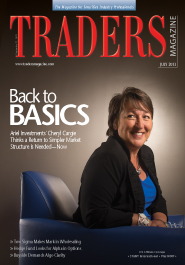Trading has gotten too complex.
Too many order types. Too many trading venues. Too many algorithms. It’s time for the equities market to get back to basics and start fresh.

That’s what trading pro Cheryl Cargie, senior vice president and head trader at Chicago-based Ariel Investments LLC, believes. And that means a return to the “good ol’ days” of trading-a simpler time, she said. Her ideal trading ecosystem wouldn’t have such things as high-frequency traders, 40-plus trading venues described as “lit” or “dark,” or prices quoted in penny or sub-penny increments.
Her ideal trading world would also prohibit exchanges from paying rebates to high-frequency traders. The public stock exchanges would go back to being nonprofit entities, she added. Lastly, there’d be markedly fewer order types.
“I’m all about old-school trading,” Cargie said. “If you can end payment for flow and take away the pressure for exchanges to turn a profit, then maybe HFT will go away and real liquidity will come back to the market.”
Tough words.
Cargie wants to find natural liquidity easily, and in today’s complex market structure, it is harder than ever to find it, she said. Cargie has been in the trading business since 1986. She remembers a simpler market structure, when the floor specialist was a friend and the New York Stock Exchange was “the biggest dark pool” of them all.
That’s when she began trading. Armed with a degree in finance, the then-23-year-old received a two-week crash course from anyone who would help.
“The hardest part of this baptism by fire was learning the trading desk language,” Cargie recalled. “And the language was spoken in short bursts followed by a hang-up.”
Despite the short calls, and after many of these staccato-burst exchanges, Cargie caught onto the language of trading-hitting bids, lifting offerings, butterfly stips and barbell trades. It was pure trading and exciting.
But it was the adrenaline rush of the trading desk-sitting amongst the shouting, the camaraderie, the raw energy of the desk-that captivated her then and now, she said. “In college they never told you what a trading desk was like, but when I got there and took it all in, I knew I wanted to stay.”
To read the entire article, please access the current issue of Traders Magazine.



